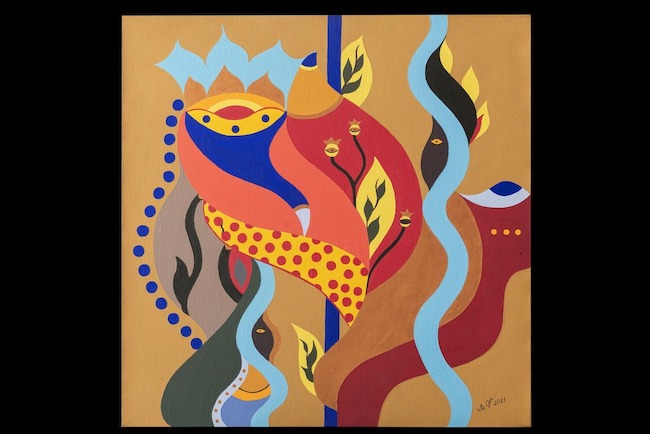L’attitudine ad adottare un linguaggio espressivo semplice, lineare, appartiene a tutti quegli artisti che in qualche modo hanno il bisogno di andare oltre la realtà contingente, pur mantenendo con essa un contatto necessario a comprenderne i risvolti e le complessità ma un attimo dopo fuggendo da essi per tendere verso una soluzione differente, inaspettata, quella dell’approccio del fanciullo che non si cura dei dettagli perché sa volgere il suo sguardo alla positività che il vissuto sempre offre. Da un lato alcuni di questi creativi sostengono il distacco completo dall’osservato per entrare nel mondo dell’indefinito, dall’altro però ve ne sono alcuni che non riescono ad astrarsi completamente, hanno bisogno di mantenere un legame con ciò che l’occhio conosce per poi condurlo a inedite interpretazioni che lasciano emergere pensieri e sensazioni diverse. L’artista di cui vi parlerò oggi appartiene a questo secondo gruppo.
Intorno agli inizi del Novecento si susseguirono correnti innovative e sovversive nei confronti dell’approccio accademico all’arte che aveva contraddistinto i secoli precedenti, e che ebbero il coraggio di rompere tutti gli schemi, di interpretare l’espressività in modo del tutto inedito e a volte persino in contrasto con le regole tradizionali; l’Astrattismo, che ebbe in Vassily Kandinsky un pioniere nonché un riferimento per tutto ciò che venne dopo, scompose completamente l’immagine, annullò ogni parametro estetico e formale per sottolineare quanto l’arte fosse fine a se stessa, quanto non avesse bisogno di essere una riproduzione dell’osservato per infondere emozione, ammirazione e apprezzamento nei confronti di chi si approcciava a un dipinto o a una scultura. In particolar modo le forme stilizzate e fluttuanti di Kandinsky, con la loro morbidezza musicale e armonica, proprio perché stimolate dall’ascolto delle composizioni di Richard Wagner, inducevano le persone a perdersi all’interno di un mondo inconosciuto, costituito da segni e forme che non trovavano riscontro nella mente razionale lasciando così spazio a quella emotiva. Malgrado le idee di Kandinsky furono accantonate in virtù di un rigore plastico ben più estremo, quello del Suprematismo di Malevic e del De Stijl di Piet Mondrian, di fatto il suo legame con l’emotività e il sentire interiore divennero qualche decennio dopo base dell’intenzione pittorica dell’Espressionismo Astratto che ampliò dunque il legame con la soggettività dell’esecutore dell’opera. In parallelo alle intuizioni di Kandinsky emersero movimenti differenti che però ebbero in alcuni coraggiosi interpreti che si liberarono da regole e schemi di quelle correnti, nate per rompere i precedenti ma creandone di proprie, per seguire un percorso solitario pur rientrando di diritto nei gruppi a cui scelsero di aderire. È questo il caso di Joan Mirò, appartenente al Surrealismo ma con una visione personale, completamente diversa da quella dei suoi colleghi più figurativi, che portò l’irrealtà nel campo della semplificazione totale di matrice astrattista e vicina alla visione dei fanciulli e alla loro immediatezza di lettura sulla realtà circostante. Anche il Cubismo, nella sua geometricità, ebbe i suoi ribelli in Robert e Sonia Delauny, che si distaccarono completamente dall’immagine osservata, e scomposta attraverso la frammentazione e l’assenza di profondità e di prospettiva che contraddistinsero le opere di Pablo Picasso e Georges Braque, tendendo verso un Astrattismo in cui i colori vivaci e pieni erano essenziali all’espressività delle opere.
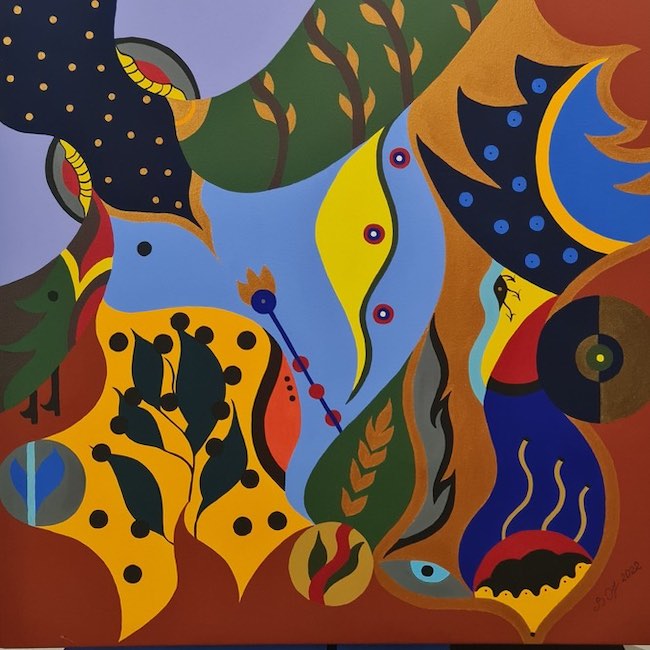
L’artista di origini russe, ma naturalizzata italiana da moltissimi anni, Valentyna Ohurstova si insinua all’interno dell’originale percorso di questi anticonformisti esponenti delle rivoluzioni espressive del secolo scorso effettuando però un’ulteriore passo per distinguersi da tutto ciò che già esiste, ma soprattutto per trovare un linguaggio unico in virtù del quale esprimere liberamente la propria essenza, la propria sensibilità e uno sguardo sulla realtà contemporanea intenso quanto necessitante di elevarsi dalla contingenza ed entrare nel mondo del sogno, dell’immaginario funzionale a generare un’evasione ma al contempo a permetterle di immergersi in quelle emozioni che diversamente non riuscirebbe a esprimere.
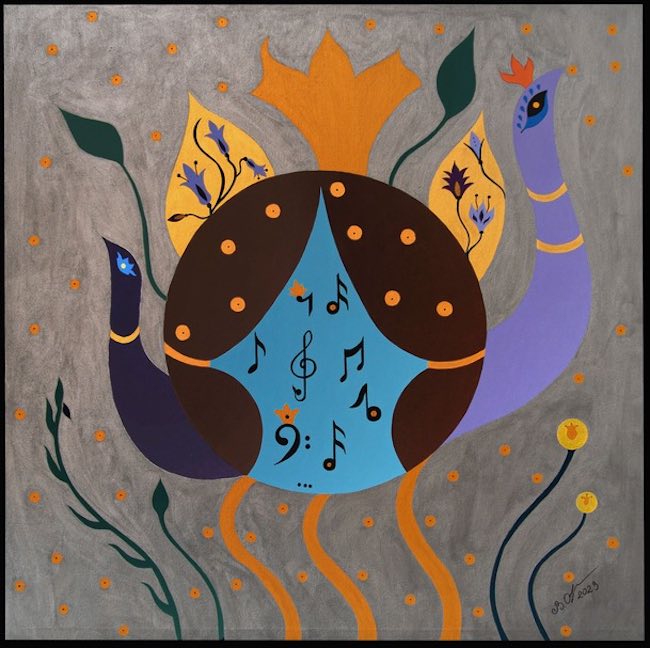
Lo stile pittorico di Valentyna Ohurstova fonde la vivacità cromatica del Cubismo Orfico dei Delauny alla stilizzazione delle immagini a metà tra figurazione e astrazione di Vassily Kandinsky e di Joan Mirò, trasportando così l’osservatore all’interno del suo universo lieve, leggero proprio perché in grado di riflettere e prendere atto del presente per poi oltrepassarlo sognando che possa essere migliore di come oggettivamente appare; la dimensione fantastica prende il sopravvento sulla realtà perché è solo uscendo dalla contingenza che è possibile avere un punto di vista più ampio, più comprensivo sulle emozioni, sugli eventi e su tutto ciò che intorno all’individuo si verifica.
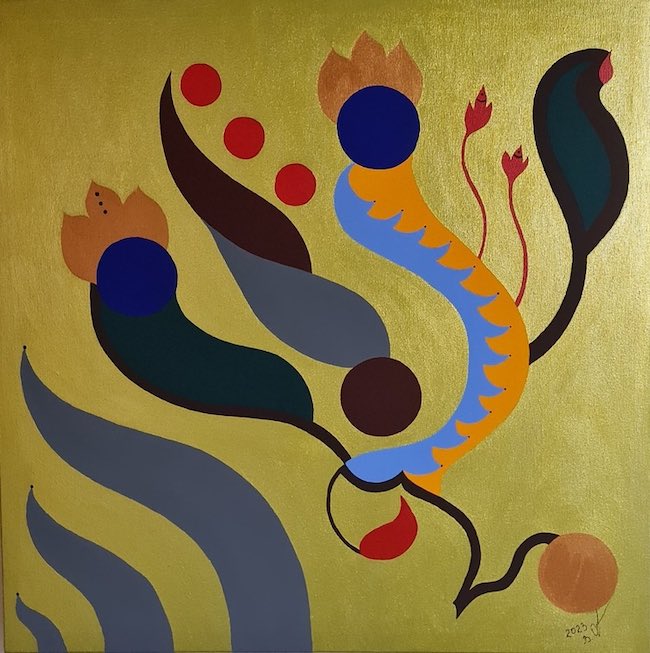
Le sue figure sinuose sembrano esprimere la volatilità delle circostanze, la mutevolezza degli avvenimenti che un attimo dopo possono trasformarsi in qualcosa di completamente diverso, modificando la prospettiva. Ciò che colpisce però delle opere della Ohurtsova è l’immediatezza, l’approccio semplice che induce l’osservatore ad avvicinarsi in maniera aperta, sollecitando quel lato fanciullesco troppo spesso dimenticato all’interno della realtà adulta; in virtù di questo sguardo ciò che prevale è la sensazione e la sollecitazione a lasciarsi condurre all’interno della dimensione fiabesca dell’artista, dove ogni cosa trova un suo senso in virtù delle tonalità piene e piatte, e delle composizioni che mantengono il contatto con una realtà immaginaria.
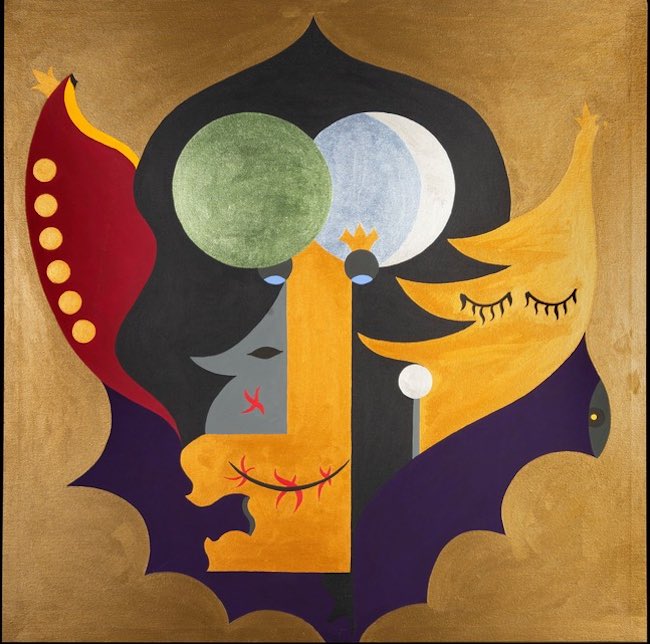
L’opera Ai Silenziosi evoca una suggestiva assenza di qualsiasi rumore, a sottolineare quanto ad alcune persone sia tolta la facoltà di parola e siano costrette a tacere le proprie sensazioni, le paure, i desideri, le speranze; le bocche cucite con delle x rosse, gli occhi chiusi, tutti gli elementi presenti nel dipinto sembrano sottolineare l’impossibilità per alcuni di esprimere liberamente il proprio pensiero e la loro personalità. Malgrado le ombre scure che contornano il centro dell’opera tuttavia, Valentyna Ohurtsova mostra il suo approccio positivo, espresso attraverso lo sfondo in foglia oro da cui si diffonde la luce, metafora della possibilità che tutto possa cambiare perché dipende dalla scelta del singolo di assoggettarsi a un destino che sembra segnato oppure alzarsi in piedi scegliendo di rifiutare l’ineluttabilità e scrivendo una pagina nuova per sé e per chi, allo stesso modo, ha bisogno di sollevare il capo e combattere per le proprie scelte.
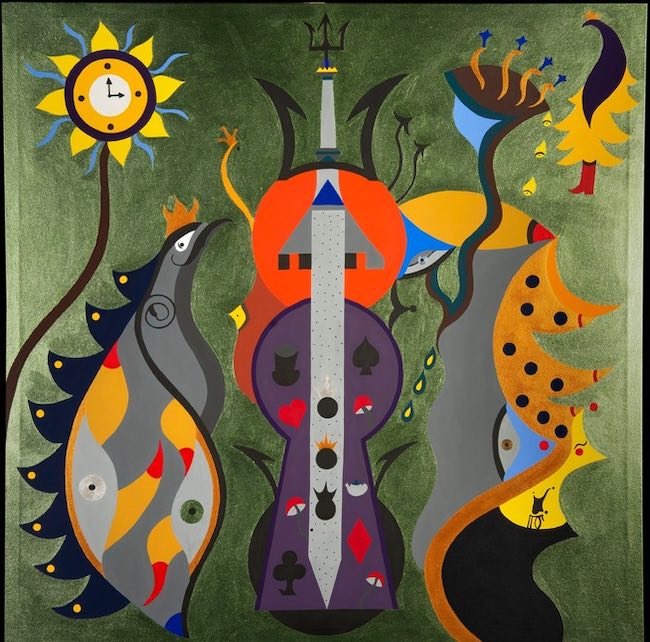
La tela Appartiene si spinge verso il Surrealismo, presenta infatti molti simboli caratteristici del movimento come il tempo, rappresentato dall’orologio all’interno dei raggi del sole, dagli occhi che in qualche modo si legano all’anima ma anche alla necessità di avere un punto di vista lucido sulle circostanze, il buco della serratura che è di fatto un invito a cercare la chiave di lettura di se stessi, della propria pura essenza, dei veri colori che si manifestano solo quando tutti gli elementi, cuore, picche, fiori e quadri, sono in equilibrio tra loro; e infine i pesci che raccontano dell’esigenza di essere fluidi, di adeguarsi ai cambiamenti e alle correnti che la vita inevitabilmente porta con sé. L’appartenenza citata nel titolo è quella dunque verso se stessi, quella ricerca costante del proprio centro che va a costituire la struttura grazie alla quale è possibile sentirsi più forti in mezzo alla moltitudine e più sicuri di non vacillare anche quando si resta soli.
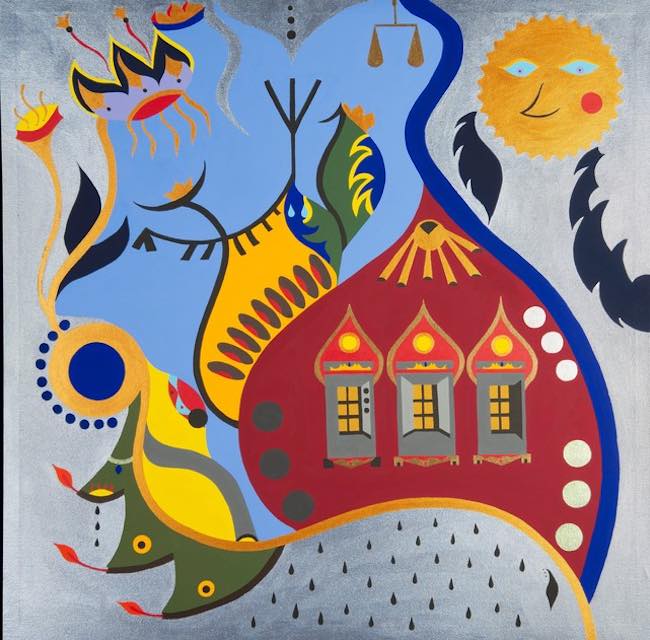
Il dipinto Il Mondo mostra uno sguardo nostalgico nei confronti delle sue origini, dei ricordi piacevoli della sua infanzia, delle case con le finestre dalla forma a ogiva tipiche dell’architettura russa, del cielo limpido, del sole che sembra osservare benevolo tutto ciò che accade sotto di sé; di fatto l’universo descritto è quello delle proprie emozioni legate indissolubilmente alla memoria emotiva, agli affetti e ai profumi di un periodo della vita in cui tutto era bello, semplice, ingenuo perché osservato con lo sguardo del bambino. Anche in questo caso la gamma cromatica è chiara, piena di luminosità e di colori vivaci e intensi che tendono verso la speranza con il verde, verso la positività con il giallo, verso l’auspicio che un’armonia e una giustizia, rappresentata dalla bilancia in alto nell’opera, possano essere raggiunte con la pace se tutti i popoli e i loro governanti, saranno in grado di ritrovare l’approccio semplice e spontaneo della purezza e dell’innocenza.
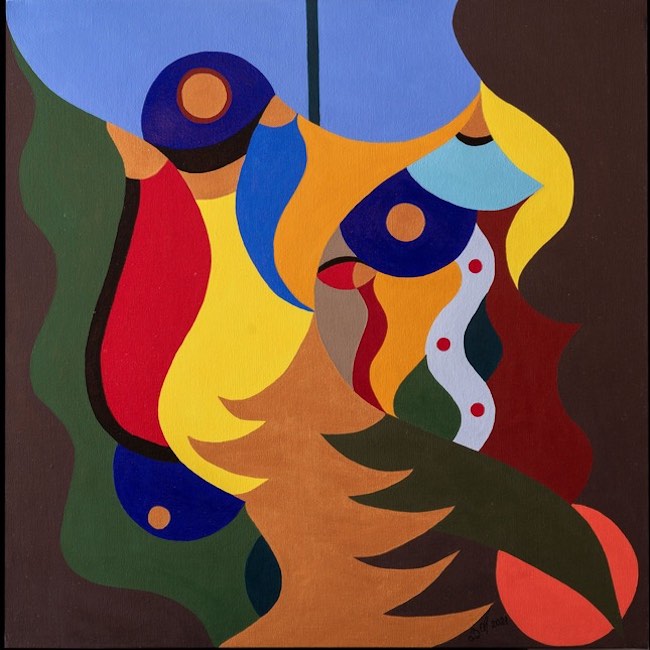
Valentyna Ohurtsova ha al suo attivo la partecipazione a molte mostre collettive e personali sia in Italia che all’estero – Copenaghen, Berlino, Parigi, Barcellona, Londra – dove riceve consensi e apprezzamenti sia dal pubblico che dagli addetti ai lavori.
VALENTYNA OURTSOVA-CONTATTI
Email: valentynaarte@gmail.com
Sito web: https://valeartohurtsova.com/
Facebook: https://www.facebook.com/valentina.ohurtzova.9
Instagram: https://www.instagram.com/_v.arte_/
Valentyna Ohurtsova, when imagery elevates the soul and moves into harmony
The aptitude to adopt a simple, linear expressive language belongs to all those artists who somehow have the need to go beyond contingent reality, while maintaining a necessary contact with it to understand its implications and complexities, but a moment later escaping from it to tend towards a different, unexpected solution, that of the approach of the child who does not care about details because he knows how to turn his gaze to the positivity that experience always offers. On the one hand, some of these creatives endorse a complete detachment from the observed in order to enter the world of the indefinite; on the other hand, however, there are some who are unable to completely abstract themselves, they need to maintain a link with what the eye knows to then lead it to new interpretations that allow different thoughts and sensations to emerge. The artist I am going to tell you about today belongs to this second group.
Around the beginning of the 20th century, followed on from the academic approach to art that had distinguished the previous centuries innovative and subversive currents that had the courage to break all the mould, to interpret expressiveness in a completely new way and sometimes even in contrast to the traditional rules; Abstractionism, which had Vassily Kandinsky as a pioneer and a reference for everything that came after, completely broke down the traditional rules of art, totally decomposed the image, annulled all aesthetic and formal parameters to emphasise how art was an end in itself, how it did not need to be a reproduction of the observed to instil emotion, admiration and appreciation in those who approached a painting or sculpture. In particular, Kandinsky‘s stylised and floating forms, with their musical and harmonic softness, precisely because they were stimulated by the listening of Richard Wagner‘s compositions, induced people to lose themselves within an unknown world, made up of signs and forms that did not match the rational mind, thus leaving room for the emotional one. Although Kandinsky‘s ideas were set aside in virtue of a much more extreme plastic rigour, that of Malevic‘s Suprematism and Piet Mondrian‘s De Stijl, in fact his link with emotionality and inner feeling became a few decades later the basis of the pictorial intention of Abstract Expressionism, which thus extended the link with the subjectivity of the artwork’s executor. Parallel to Kandinsky‘s intuitions, different movements emerged that had some courageous interpreters who freed themselves from the rules and schemes of those currents, born to break precedents but creating their own, in order to follow a solitary path even though they were rightfully part of the groups they chose to join. This is the case of Joan Mirò, who belonged to Surrealism but with a personal vision, completely different from that of his more figurative colleagues, who brought unreality into the realm of total simplification with an abstractionist matrix and close to the vision of children and their immediacy in reading the surrounding reality. Even Cubism, in its geometricity, had its rebels in Robert and Sonia Delauny, who completely detached themselves from the observed image, and decomposed it through the fragmentation and absence of depth and perspective that characterised the paintings of Pablo Picasso and Georges Braque, tending towards an Abstractionism in which bright, full colours were essential to the expressiveness of the works.
The artist of Russian origin, but naturalised Italian for many years, Valentyna Ohurstova insinuates herself within the original path of these non-conformist exponents of the expressive revolutions of the last century, taking a further step to distinguish herself from everything that already exists, but above all to find a unique language in virtue of which she can freely express her own essence, her own sensitivity and a gaze on contemporary reality as intense as it is necessary to rise from contingency and enter the world of dreams, of the imaginary functional to generate an escape but at the same time allowing her to immerse in those emotions that she would otherwise not be able to express. Valentyna Ohurstova’s pictorial style blends the chromatic vivacity of Orphic Cubism of Delaunys with the stylisation of the images halfway between figuration and abstraction of Vassily Kandinsky and Joan Mirò, thus transporting the observer into her airy universe, light precisely because she is able to reflect and take note of the present and then go beyond it, dreaming that it may be better than it objectively appears; the fantastic dimension takes over from reality because it is only by stepping out of contingency that it is possible to have a broader, more comprehensive viewpoint on emotions, events and everything that occurs around the individual. Her sinuous figures seem to express the volatility of circumstances, the mutability of events that a moment later can turn into something completely different, changing the perspective. What is striking about Ohurtsova‘s artworks, however, is the immediacy, the simple approach that induces the observer to approach them in an open manner, stimulating that childlike side that is too often forgotten within the adult reality; by virtue of this gaze, what prevails is the sensation and the invitation to let oneself be led into the artist’s fairy-tale dimension, where everything finds its own sense by virtue of the full and flat tones, and the compositions that maintain contact with an imaginary reality. The painting To the Silent Ones evokes a suggestive absence of any noise, emphasising how some people are deprived of the power of speech and are forced to keep quiet about their feelings, fears, desires and hopes; the mouths sewn shut with red x’s, the closed eyes, all the elements in the painting seem to emphasise the impossibility for some to freely express their thoughts and personalities.
In spite of the dark shadows surrounding the centre of the work, however, Valentyna Ohurtsova shows her positive approach, expressed through the gold leaf background from which the light spreads, a metaphor for the possibility that everything can change because it depends on the individual’s choice to submit to a destiny that seems marked out or to stand up, choosing to reject inevitability and writing a new page for oneself and for those who, likewise, need to raise their heads and fight for their choices. The canvas Belongs pushes towards Surrealism, in fact it presents many symbols characteristic of movement such as time, represented by the clock inside the sun’s rays, the eyes that somehow connect to the soul but also to the need to have a lucid point of view on circumstances, the keyhole that is in fact an invitation to search for the key to reading oneself, one’s own pure essence, of the true colours that only manifest themselves when all the elements – heart, spades, clubs and diamonds – are in balance with each other; and finally, the fish that tell of the need to be fluid, to adapt to the changes and currents that life inevitably brings. The sense of belonging mentioned in the title is therefore that towards oneself, that constant search for one’s own centre that constitutes the structure thanks to which it is possible to feel stronger in the midst of the multitude and more sure of not wavering even when one is alone. The painting The World shows a nostalgic glance towards his origins, the pleasant memories of his childhood, the houses with ogive-shaped windows typical of Russian architecture, the clear sky, the sun that seems to benevolently observe everything that happens beneath it; the universe described is that of her own emotions indissolubly linked to her emotional memory, to the affections and scents of a period of life in which everything was beautiful, simple, naive because it was observed with the gaze of a child. Here too, the chromatic range is clear, full of luminosity and bright, intense colours that tend towards hope with green, towards positivity with yellow, towards the hope that harmony and justice, represented by the balance at the top of the artwork, can be achieved with peace if all peoples and their rulers are able to rediscover the simple and spontaneous approach of purity and innocence. Valentyna Ohurtsova has taken part in many group and solo exhibitions both in Italy and abroad – Copenhagen, Berlin, Paris, Barcelona, London – where she has received acclaim and appreciation from both the public and professionals.


